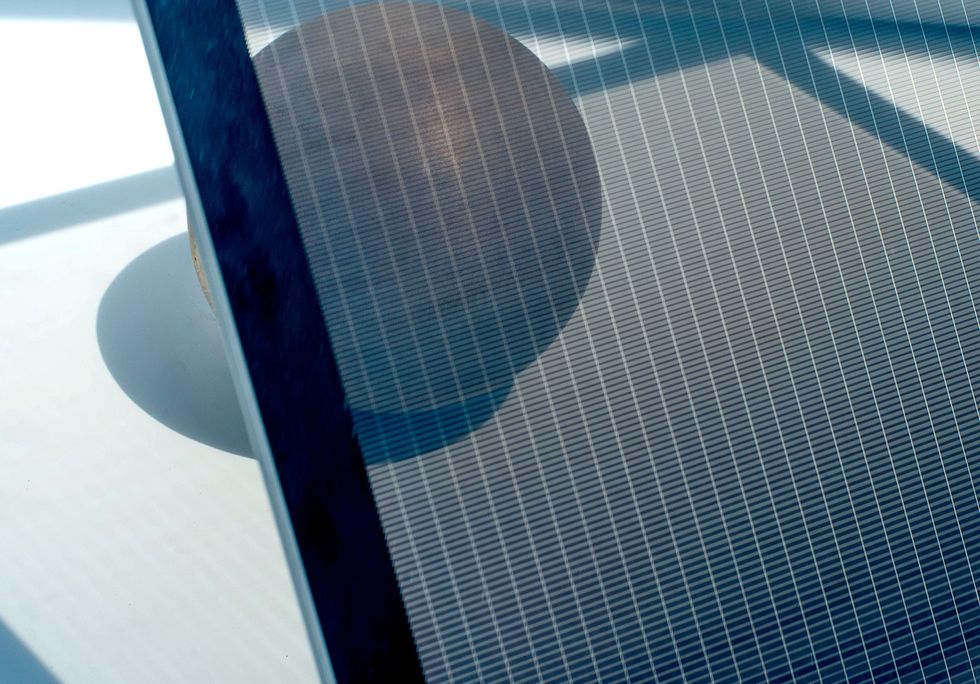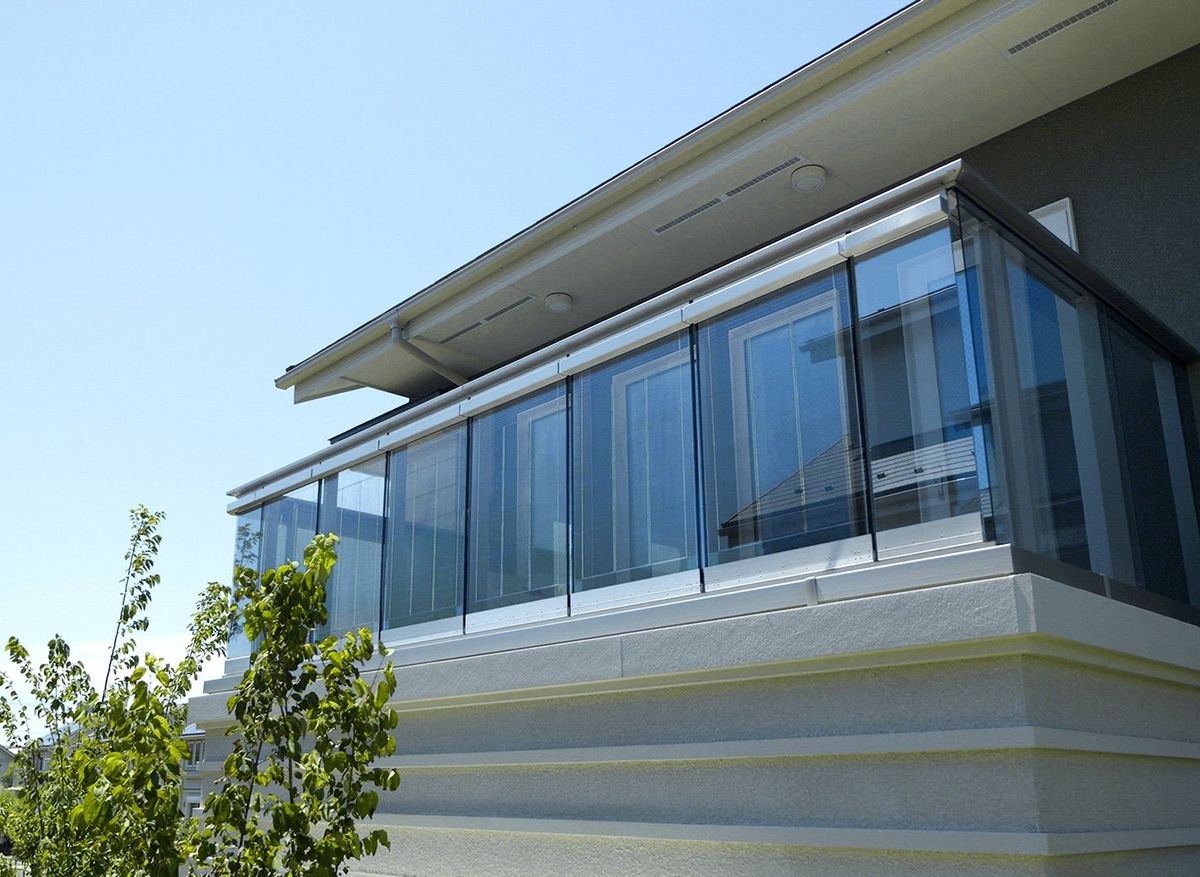This past August, Panasonic Holdings began testing and demonstrating a prototype version of its perovskite photovoltaic material. The prototype is in the form of semi-transparent glass balustrade panels on the balcony of a model house just south of Tokyo. The panels, each measuring nearly a meter in height and nearly 4 meters in width, are just one of the ways Panasonic intends to enter the building-integrated photovoltaics (BIPV) business.
Sandwiching the perovskite between glass means that it can serve as a building’s actual facades and walls while also generating electricity for on-site use or export to the grid, says Yukihiro Kaneko, general manager of Panasonic’s Applied Materials and Technology Center. He adds that Panasonic can change the material’s level of transparency during the fabrication process, according to a customer’s requirements, which can make it suitable for use as windows.
“Regarding perovskite transparency, what is making the difference is the value of the bandgap,” says Stefaan De Wolf, an engineering professor at King Abdullah University of Science and Technology (KAUST), in Saudi Arabia. “For silicon of a typical thickness (100 to 150 micrometers), it will absorb all available visible photons at 1.2 electron-volts. For perovskite, the bandgap is usually at least 1.5 eV, allowing transmission of the red part of the spectrum. Moreover, perovskite can be printed in patterns, allowing it to act as a neutral-density filter [for color management].”

But there’s a downside, given the linear relationship that exists between the transparency rate and the perovskite panel’s conversion efficiency. For example, if 50 percent transparency is required in a panel that has an energy-conversion efficiency of 20 percent, the conversion energy efficiency would actually decrease to 10 percent.
The term perovskite refers to a family of compounds, and when used in solar cells, the materials are called perovskite because of their structural similarity to a mineral called perovskite discovered in Russia in 1839. Panasonic has developed its own version of the material with Japan’s New Energy and Industrial Technology Development Organization (NEDO). In 2020, Panasonic achieved a record 17.9 percent conversion efficiency for a large-size perovskite panel.
While silicon is commonly used for solar panels today, perovskite has several advantages, including simpler fabrication methods, lower production costs, flexible design capability, the potential for higher energy conversion efficiencies, and no need for rare earth metals. But it also has some drawbacks, notably that the material will break down when exposed to heat, moisture, or snow—in other words, the very conditions that Panasonic’s BIPV products will constantly face.
To counter this, Panasonic uses two approaches to protect its BIPV devices from the weather.
“On the material side, we have developed a robust material by doping the perovskite with certain atoms such as cesium and rubidium,” says Kaneko. The results of the research that led to this development, as well as an achieved energy conversion efficiency rate of 20.8 percent, were published on 11 January 2019 in Advanced Materials.
“And as well as achieving high thermal stability, the architectural glass is completely sealed and protects the perovskite from moisture and air,” adds Kaneko. “The double glass also gives panels rigidity.”

To create the solar panels, Panasonic uses a combination of alternating laser inscribing and inkjet printing to fabricate the perovskite voltaic circuitry. On a sheet of glass, a laser first inscribes the pattern for a transparent conductive oxide layer, which the inkjet printer then lays down. Next, an electron-transport layer is inscribed, and electron-transport materials are laid down. This is followed by the perovskite layer, and then materials for the hole-transport layer, and so on until the solar-cell circuity is completed and the second glass sheet is attached and sealed.
“This process method enables us to be flexible in terms of panel size, transparency, and design,” says Kaneko.
Kaneko says that Panasonic is getting feedback from potential customers regarding the balustrade prototype panels, and requests to test different-size panels. Beginning next April, Panasonic will start up a pilot production line for 1-by-1.8-meter panels while also likely upgrading the materials and design based on feedback from the company’s ongoing testing. Eventually, he estimates they will be able to produce panels as large as 1.8 by 4 meters.
The company’s strategy is to avoid direct competition with Chinese manufacturers of silicon and perovskite panels, which have no peers when it comes to turning out standard-size panels at low cost. Instead, “In the BIPV business, different buildings require different-sized windows and walls,” says Kaneko. “Our flexible inkjet production method means we can customize our solar panels to meet such requirements.”
“BIPV is an attractive market and can be a meaningful entry point for perovskite technologies and PV in general,” says KAUST professor De Wolf. “These technologies may also be exploited to block heat from entering a building, reducing requirements for air conditioning. And because perovskite can be printed, it offers possibilities for pairing performance with aesthetics.”
Panasonic plans to commercialize its BIPV products within five years, at which point the company expects the energy conversion rate of its perovskite solar cells to be nearly 20 percent.
This article appears in the February 2024 print issue.
- A Bright Spot for Solar Windows Powered by Perovskites - IEEE ... ›
- Encapsulated Perovskite Solar Cells Show Resilience - IEEE ... ›



